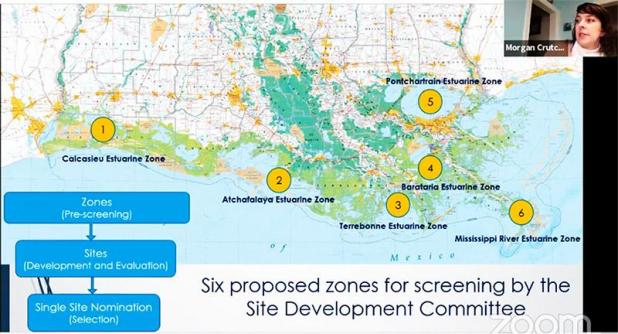
Morgan Crutcher of the Governor’s Office of Coastal Activities speaks during Friday’s St. Mary Excel virtual meeting about the planned Louisiana National Estuarine Research Reserve site. Shown are the six zones under considering for the state’s reserve.
St. Mary Excel Facebook screenshot
UPDATED: Locals learn more about NERR site selection process
The process of selecting and getting a National Estuarine Research Reserve System site in operation takes, on average, four to six years.
That was one of the many pieces of information locals learned in presentations from a representative from the Governor’s Office of Coastal Activities and the National Oceanic and Atmospheric Administration during Friday’s virtual St. Mary Excel meeting.
Currently, Louisiana is in the nomination/selection process of a site for the Louisiana National Estuarine Research Reserve, or LaNERR, in accordance with NOAA guidelines. A site will be chosen from among six zones along the Louisiana coast. The Atchafalaya Estuarine Zone, which includes the local area, is one of those zones.
St. Mary Excel is promoting the parish as a site for such a reserve. The group says the reserve would mean educational opportunities for young people as well as potential tourism dollars for the parish.
The Morgan City, Berwick and St. Mary Parish councils and the St. Mary Parish School Board have adopted resolutions in favor of a reserve in the parish.
At St. Mary Excel’s meeting, Kristen Ransom of NOAA’s Office of Coastal Management and Morgan Crutcher of the Governor’s Office of Coastal Activities discussed the federal and state roles in this process.
In the current phase of the LaNERR development, the Atchafalaya Estuarine Zone is competing with the Calcasieu, Terrebonne, Pontchartrain, Barataria and Mississippi River Estuarine zones for the coveted site.
Sites will be rated in accordance with how compatible they are with criteria in NOAA’s guidelines that are adapted at the state level to reflect Louisiana’s characteristics, Crutcher said.
In lobbying for the site, St. Mary Parish President David Hanagriff cited multiple reasons why the LaNERR should be here. He touted the parish’s central location in the state with the Rockefeller Wildlife Refuge west of the parish, the Atchafalaya Basin north of St. Mary and the Gulf of Mexico to the south. He also said the parish is centralized with the University of Louisiana at Lafayette, Nicholls State University and LSU nearby, there are two land-building areas in St. Mary and the area’s history of fishing, hunting and oil and gas.
“We know how important the environment is, and we know how important it is to make sure that environment is safe for our children going forward,” Hanagriff said. “So I think St. Mary Parish would be an excellent choice for this particular facility here.”
Crutcher stressed that wherever the reserve is placed, it will not impact activities, such as hunting or fishing, which already had been ongoing in those areas.
To narrow the potential sites to one to three possibilities, a site development committee made up of 80 members, including state and federal agencies, tribes, universities and others, will look at the list and compare how they meet the NOAA guidelines for a NERR.
Once those sites have been pared, public meetings will be held later this year where the one to three potential sites that emerged from the initial judging will be presented. At these town hall meetings, the public can make their cases for particular sites, Crutcher said.
“Those town halls are really going to be key, because that feedback will go directly into the proposal for each site that will then be considered for selection,” Crutcher said.
Once the reserve site is selected at the state level, the choice is submitted to NOAA for approval or denial.
“The not accepting it doesn’t happen very often,” Ransom said.
Wherever the reserve will be, it will join 29 that are protected across the United State and Puerto Rico.
There are more than 1.3 million acres of estuary habitat in the country that are protected.
“We cover the range of different types of habitats and ecosystems in the country as well,” Ransom said.
The largest in the country is more than 372,000 acres in Alaska, while the smallest is about 500 acres in Ohio. Many are less than 20,000 acres, Crutcher said. She said Louisiana’s could be big or it could be small.
“It just depends on how these sites measure up to the criteria that NOAA provides in its guidance for selecting the site,” she said.
The land will be a combination of state and federal property, with the federal share not exceeding 49%, Crutcher said.
The federal government would provide 70% of the LaNERR’s funding, with the state picking up the rest.
Among the benefits of estuaries Ransom listed are they are important in healthy ecosystems, provide protection from hurricanes and benefit an area’s economy
“These are crucial resources for us to make sure stick around,” she said of estuaries.
By joining the national system of estuarine reserves, Crutcher said it allows the state to share its story with the nation.
As has been stressed previously in St. Mary Excel presentations to local government bodies in securing support for the Atchafalaya Estuarine Zone, community support is important for any of the six zones to be chosen.
“I think one of the things that makes or breaks a designation process is community support,” Ransom said.
